Abstract
Interference with venous outflow from a limb to stimulate fracture repair and bone growth has a long history, and its beneficial effects have been confirmed by many experimental and clinical studies. With the development of fracture fixation systems, the therapeutic use of circulatory intervention became redundant. Recently, a venous tourniquet effect has been cited to explain the enhancement of bone healing observed after fracture fixation with the Aircast system. As bone appears to be altered by venous stasis, it is important to characterise the vascular perturbations leading to these changes. Previous studies have often given conflicting results. This study investigated the short and long term haemodynamic effects of femoral vein ligation. Changes in blood flow rate and blood volume in the distal femur and proximal tibia of the rat were examined at 6 h and 1, 3 and 7 d following unilateral femoral vein ligation, and at 8 and 16 wk. Blood flows and volumes were generally reduced in the ligated limb 6 h after femoral vein ligation. This initial depression was followed by a relative increase (comparing the ligated limb with the contralateral unoperated bone) in blood volume during the 1st week. A significant relative reduction in epiphyseal vascular space was observed after 16 wk. A sustained reduction of arterial input to whole femora and tibiae was present in the ligated limb throughout the investigation although, for the cancellous knee joint epiphysis of the tibia, a localised relative increase in flow was apparent during the 1st week, again comparing the ligated limb with the nonligated contralateral bone.(ABSTRACT TRUNCATED AT 250 WORDS)
Full text
PDF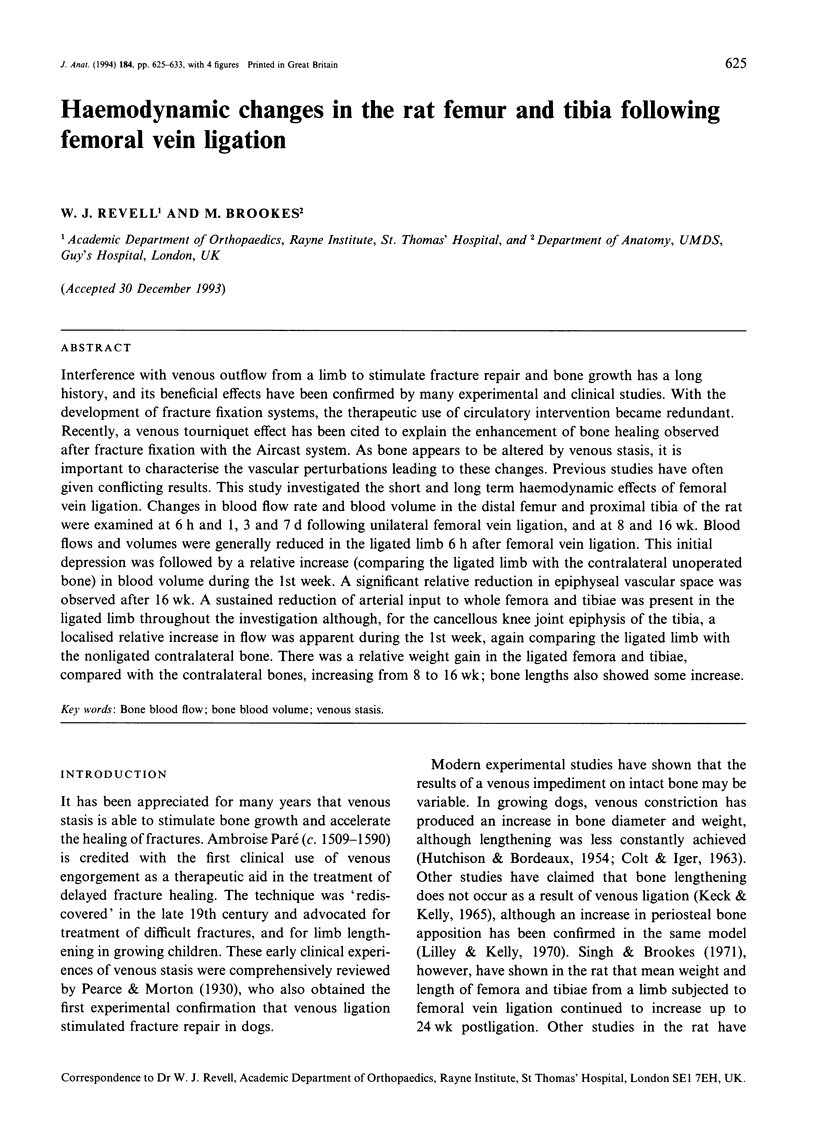
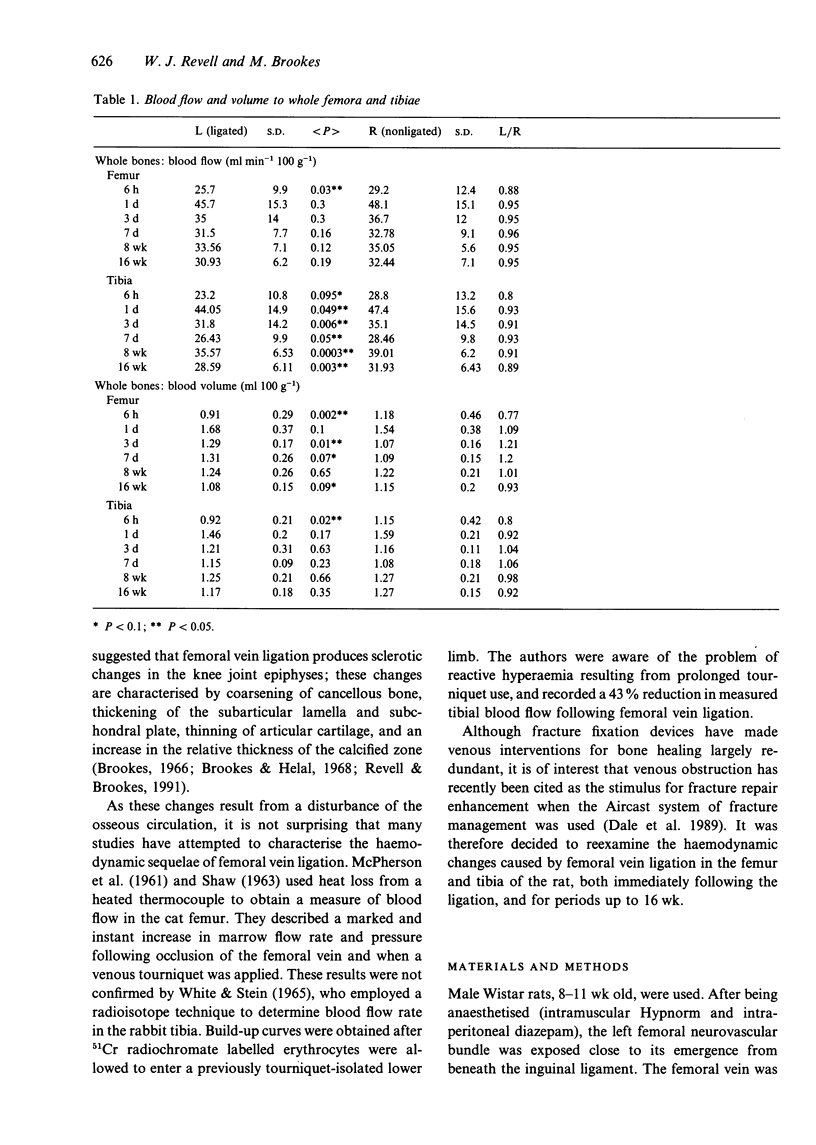


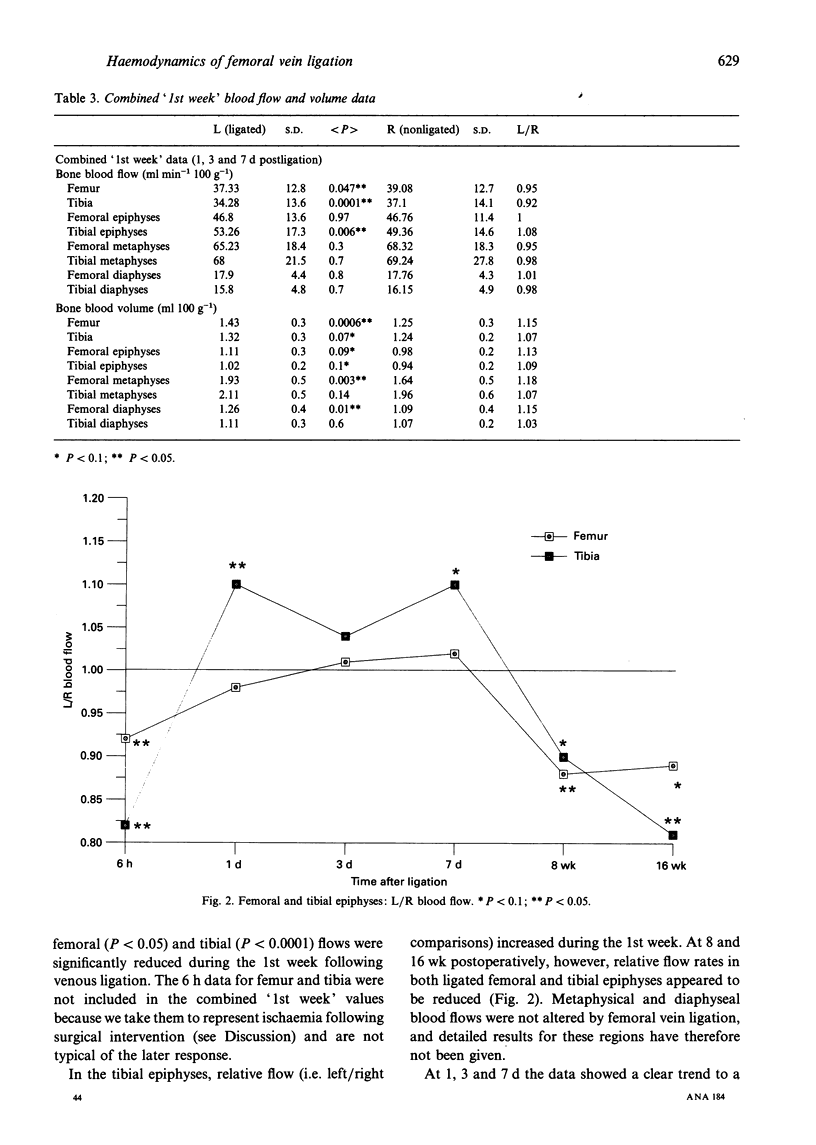

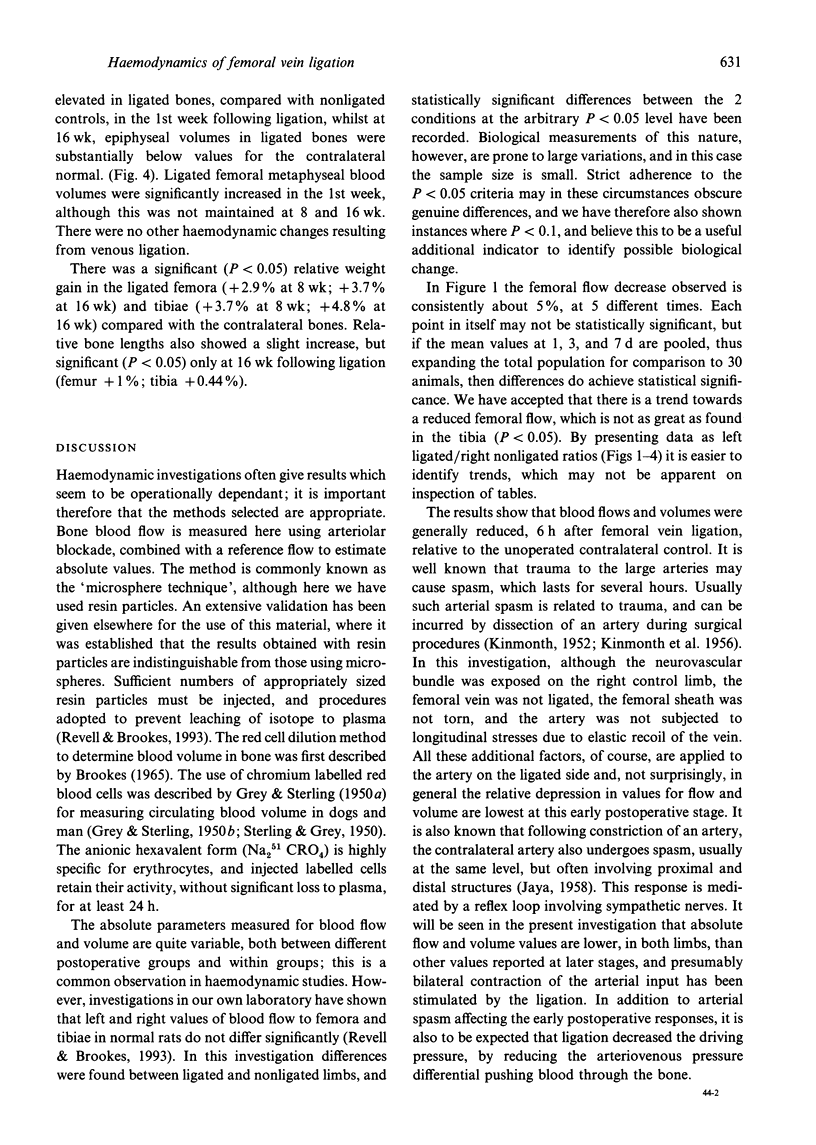

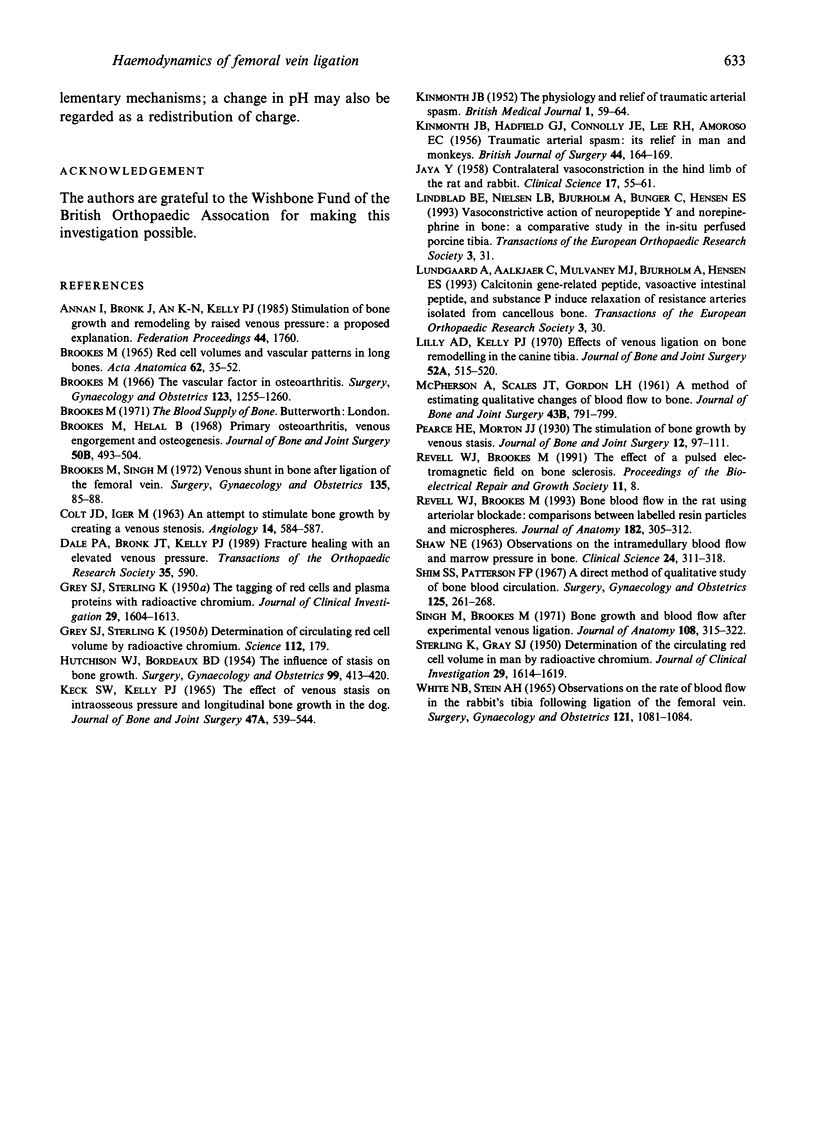
Selected References
These references are in PubMed. This may not be the complete list of references from this article.
- AMOROSO E. C., CONNOLLY J. E., HADFIELD G. J., KINMONTH J. B., LEE R. H. Traumatic arterial spasm; its relief in man and in monkeys. Br J Surg. 1956 Sep;44(184):164–169. doi: 10.1002/bjs.18004418411. [DOI] [PubMed] [Google Scholar]
- Brookes M., Helal B. Primary osteoarthritis, venous engortement and osteogenesis. J Bone Joint Surg Br. 1968 Aug;50(3):493–504. [PubMed] [Google Scholar]
- Brookes M. Red cell volumes and vascular patterns in long bones. Acta Anat (Basel) 1965;62(1):35–52. doi: 10.1159/000142742. [DOI] [PubMed] [Google Scholar]
- Brookes M., Singh M. Venous shunt in bone after ligation of the femoral vein. Surg Gynecol Obstet. 1972 Jul;135(1):85–88. [PubMed] [Google Scholar]
- Brookes M. The vascular factor in osteoarthritis. Surg Gynecol Obstet. 1966 Dec;123(6):1255–1260. [PubMed] [Google Scholar]
- COLT J. D., IGER M. AN ATTEMPT TO STIMULATE BONE GROWTH BY CREATING A VENOUS STENOSIS. Angiology. 1963 Dec;14:584–587. doi: 10.1177/000331976301401205. [DOI] [PubMed] [Google Scholar]
- GRAY S. J., STERLING K. Determination of circulating red cell volume by radioactive chromium. Science. 1950 Aug 11;112(2902):179–180. doi: 10.1126/science.112.2902.179. [DOI] [PubMed] [Google Scholar]
- GRAY S. J., STERLING K. The tagging of red cells and plasma proteins with radioactive chromium. J Clin Invest. 1950 Dec;29(12):1604–1613. doi: 10.1172/JCI102403. [DOI] [PMC free article] [PubMed] [Google Scholar]
- HUTCHISON W. J., BURDEAUX B. D., Jr The influence of stasis on bone growth. Surg Gynecol Obstet. 1954 Oct;99(4):413–420. [PubMed] [Google Scholar]
- JAYA Y. Contralateral vasoconstriction in the hind limb of the rat and rabbit. Clin Sci. 1958 Feb;17(1):55–61. [PubMed] [Google Scholar]
- KECK S. W., KELLY P. J. THE EFFECT OF VENOUS STASIS ON INTRAOSSEOUS PRESSURE AND LONGITUDINAL BONE GROWTH IN THE DOG. J Bone Joint Surg Am. 1965 Apr;47:539–544. [PubMed] [Google Scholar]
- KINMONTH J. B. The physiology and relief of traumatic arterial spasm. Br Med J. 1952 Jan 12;1(4749):59–64. doi: 10.1136/bmj.1.4749.59. [DOI] [PMC free article] [PubMed] [Google Scholar]
- Lilly A. D., Kelly P. J. Effects of venous ligation on bone remodeling in the canine tibia. J Bone Joint Surg Am. 1970 Apr;52(3):515–520. [PubMed] [Google Scholar]
- Revell W. J., Brookes M. Bone blood flow in the rat using arteriolar blockade: comparisons between labelled resin particles and microspheres. J Anat. 1993 Jun;182(Pt 3):305–312. [PMC free article] [PubMed] [Google Scholar]
- SHAW N. E. Observations on the intramedullary blood-flow and marrow-pressure in bone. Clin Sci. 1963 Jun;24:311–318. [PubMed] [Google Scholar]
- STERLING K., GRAY S. J. Determination of the circulating red cell volume in man by radioactive chromium. J Clin Invest. 1950 Dec;29(12):1614–1619. doi: 10.1172/JCI102404. [DOI] [PMC free article] [PubMed] [Google Scholar]
- Singh M., Brookes M. Bone growth and blood flow after experimental venous ligation. J Anat. 1971 Feb;108(Pt 2):315–322. [PMC free article] [PubMed] [Google Scholar]
- White N. B., Stein A. H., Jr Observations on the rate of blood flow in the rabbit's tibia following ligation of the femoral vein. Surg Gynecol Obstet. 1965 Nov;121(5):1081–1084. [PubMed] [Google Scholar]


